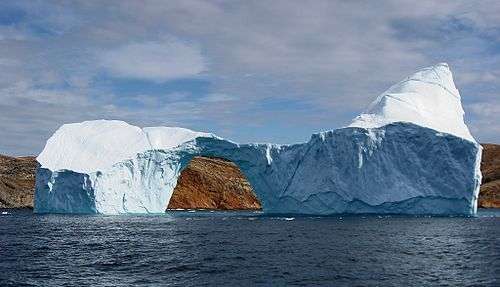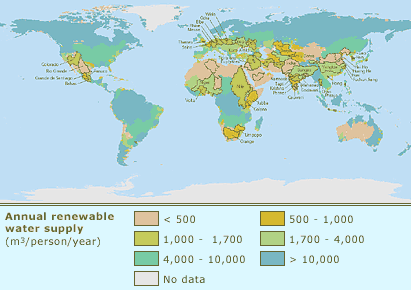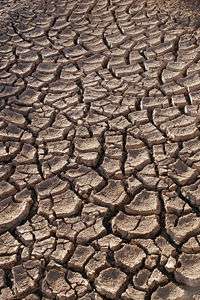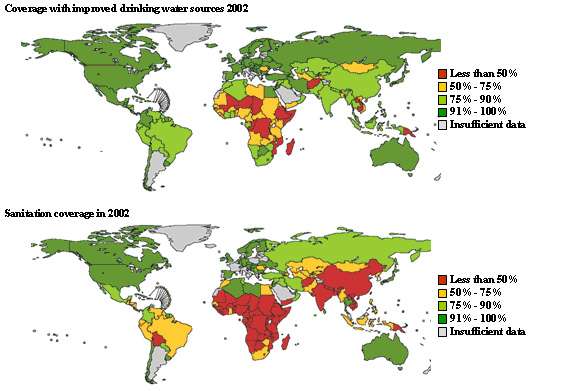High School Earth Science/Problems with Water Distribution
< High School Earth ScienceHumans are facing a worldwide water crisis according to the United Nations. The crisis includes worldwide shortages of fresh water that humans can access, scarcity of safe drinking water supplies, and water pollution.
Learning Objectives
- Explain why water shortages are increasingly frequent throughout the world.
- Discuss why 1.1 billion people (one fifth of the people on Earth) do not have access to safe drinking water.
- Explain why humans can use less than one percent of all water on Earth.
- Discuss the ways in which human water demands are unsustainable.
World Water Supply and Distribution
Water is everywhere. More than 70% of the Earth's surface is covered by water. The Earth has a limited supply of water that we can use. There are supplies of freshwater in lakes, rivers, streams, swamps, reservoirs, and even underground water rich regions of soil and rock, called aquifers. Almost anywhere you stand, there is water somewhere beneath you. Sometimes that water is just several meters below you, sometimes it is deeper within the Earth.
Still, this supply of freshwater is less than 1% of all of the water on Earth. Why is so little water available for human use? Two reasons:
- For most of our needs, humans cannot use saltwater, which makes up 97-98% of all water on Earth.
- Humans cannot use most of the freshwater on Earth, because it is frozen in glaciers and icebergs, mainly in Greenland and Antarctica (Figure 21.10).

A common misconception is that water shortages can be solved by desalination, removing salt from seawater. This is because the desalination process requires so much energy and is so costly, that it is not an economical way to increase freshwater resources.
Water Distribution
Look closely at the climates of different regions around the Earth. Some places have water rich climates, while many others do not. Roughly 40% of the land on Earth is arid or semiarid, which means it receives little or almost no rainfall.

Global warming affects patterns of rainfall and water distribution. As the Earth warms, regions that currently receive an adequate supply of rain may shift. Regions of Earth that normally are low pressure areas may become areas where high pressure dominates. That would completely change the types of plants and animals that can live successfully in that region.
In 1995, about 40% of the world's population faced water scarcity (Figure 21.11). Scientists believe that by the year 2025, nearly half of the world's people won't have enough water to meet their daily needs. Nearly one quarter of the people in the world will have less than 500 m3 of water per person to use in an entire year. A cubic meter of water equals 1,000 liters. That means in certain areas of the world, many people will have less water available in a year than some people in the United States use in one day.

Water Shortages
As we continue to use our precious freshwater supplies, scientists expect that we will encounter several different types of problems. We currently irrigate our crops using supplies of groundwater in aquifers underground. When we have used up these groundwater supplies, we will not be able to grow as many different types of crops or we will have lower yields of the crops we grow. Using our freshwater often adds many different types of dissolved materials to the freshwater supply. This use may lead to pollution of our water resources and cause harm not only to humans but to many life forms, reducing our biodiversity. Most importantly, as our water supplies become scarce, there will be conflicts between individuals who have enough clean water and those who do not (Figure 21.12). As with any limited resource, this conflict could produce warfare.

Two of the most serious problems facing humans today are shortages of fresh water and the lack of safe drinking water.
Humans use six times as much water today as we did a hundred years ago. As the number of people on Earth continues to rise, our demand for water grows. Also, people living in developed countries use more water per person than individuals in lesser developed countries. This is because most of our activities today, such as farming, industry, building, and lawn care, are all water-intense practices, practices that require large amounts of water.

Droughts occur when for months or years, a region experiences unusually low rainfall (Figure 21.13). Periods of drought naturally make water shortages worse. Human activities, such as deforestation, can contribute to how often droughts occur. Trees and other land plants add water back into the atmosphere through transpiration. When trees are cut down, we break this part of the water cycle. Some dry periods are normal and can happen anywhere in the world. Droughts are a longer term event and can have serious consequences for a region. Because it is difficult to predict when droughts will happen, it is difficult for countries to predict how serious water shortages will be each year.
Water shortages hurt human health, agriculture and the environment. What happens when water supplies run out? In undeveloped regions in the world, people are often forced to move to a place where there is water. This can result in serious conflicts, even wars, between groups of people competing for water.
Water disputes happen in developed countries as well. Water-thirsty regions may build aqueducts, large canals or pathways to import water from other locations. For example, several cities in arid regions of the United States import water from the Colorado River. So much water is taken from the river that it can end as just a trickle when it reaches Mexico. Years ago, Mexico could depend on the river supplying water for irrigation and other uses. Today that water resource is gone from importing water upstream.
Some of the biggest legal battles in the United States have been over water rights, including access to the Colorado River. Water disputes may have led to some of the earliest wars known.

Problems with Water Quality
Scarcity of Safe Drinking Water
The next time you get water from your faucet, imagine life in a country that cannot afford the technology to treat and purify water. What would it be like if your only water came from a polluted river where sewage was dumped? Your only choice would be to drink polluted water. One fifth of all people in the world, more than 1.1 billion people, do not have access to safe water for drinking, personal cleanliness and domestic use. Unsafe drinking water can carry many disease-causing agents, such as infectious bacteria, toxic chemicals, radiological hazards, and parasites.
One of the leading causes of death worldwide is waterborne disease, disease caused by unsafe drinking water. It is also the leading cause of death for children under the age of five. Many children die when they only have unsafe drinking water and lack of clean water for personal hygiene. About eighty-eight percent of all diseases are caused by drinking unsafe water. At any given time, half of the world's hospital beds are occupied by patients suffering from a waterborne disease. The water you get from a faucet is safe because it has gone through a series of treatment and purification processes to remove contaminants.
Economic Considerations
A glass of water may be free in a restaurant, but this does not reflect its value as a resource. Water is often regarded as more valuable than gold, because human survival depends on having steady access to it.
Water scarcity can have dire consequences for the people, the economy and the environment. Without adequate water:
- Crops and livestock dwindle and people go hungry.
- Industrial, construction, and economic development is halted.
- The risk of regional conflicts over scarce water resources rises.
- Ultimately some people die from lack of water.
Finding safe drinking water poses further challenges. What does it take for a country to provide its people with access to safe drinking water? It takes sophisticated technology to purify water, which removes harmful substances and pathogens, disease-causing organisms. Most developing countries lack the finances and the technology needed to supply their people with purified drinking water.
Water resources are so valuable, that wars have been fought over water rights throughout history. In many cases, water disputes add to tensions between countries where differing national interests and withdrawal rights have been in conflict (Figure 21.15).
Some of today's greatest tensions are happening in places where water is scarce. Water disputes are happening along 260 different river systems that cross national boundaries including water disputes between:
- Iraq, Iran, and Syria
- Hungary and Czechoslovakia
- North and South Korea
- Iran and Syria
- Israel and Jordan
- Egypt and Ethiopia
International water laws, such as the Helsinki Rules, help interpret water rights among countries.
Lesson Summary
- Water is a renewable resource, but it is not unlimited. Humans are limited to less than one percent of the water on Earth. Also, water is not evenly distributed across the globe.
- Water is so valuable that countries have fought each other over water rights throughout history. Water shortages and water pollution have become so serious across the world, that some organizations call our water status a "water crisis". The crisis is blamed on overpopulation, overuse of water, pollution, and global warming.
- Undeveloped countries are rarely able to afford water treatment and purification facilities, unless other countries and international organizations help.
Review Questions
- If most of the Earth is covered with water, how can there be water shortages?
- Why are waterborne diseases more common in less developed countries than developed countries?
- Why does the United Nations describe the current water status today as a crisis?
- How do droughts affect water supplies?
- Why do water disputes happen?
- Give two reasons why water shortages are happening around the world today?
Vocabulary
- aquifer
- Regions of soil or rock that are saturated with water.
- arid
- Regions without enough water for things to grow.
- drought
- A long period of lower than normal rainfall for a particular region.
- pathogen
- Disease causing organisms.
Points to Consider
- What can we do to help the one fifth of the people on Earth who do not have access to safe drinking water?
- How can we reduce water shortages due to overuse, overpopulation, and drought?
- Water is so valuable that wars have been fought over it throughout history. Could conserving freshwater now help avoid future wars?